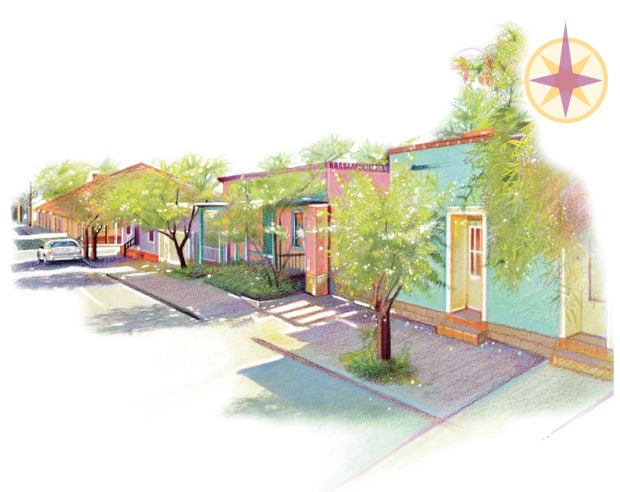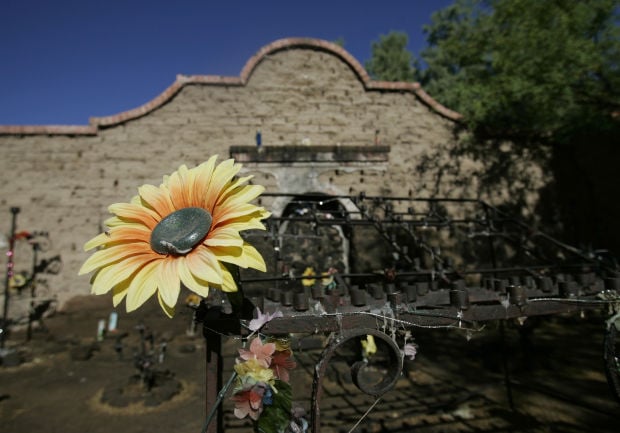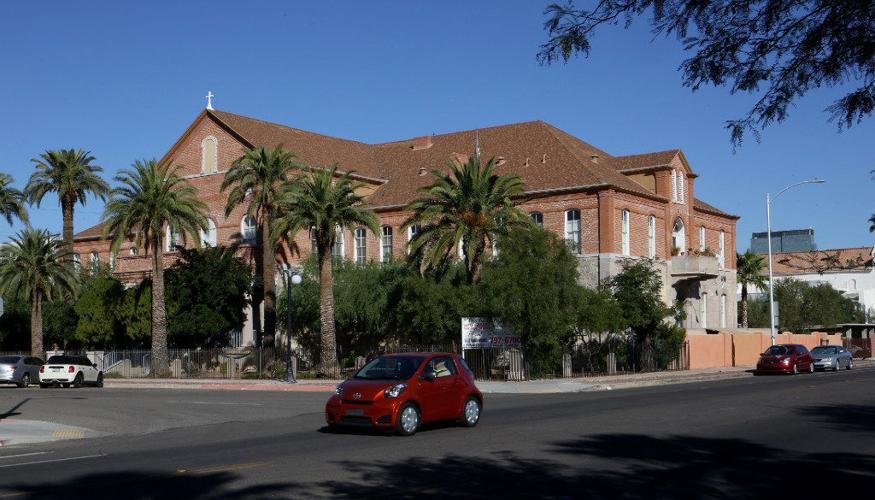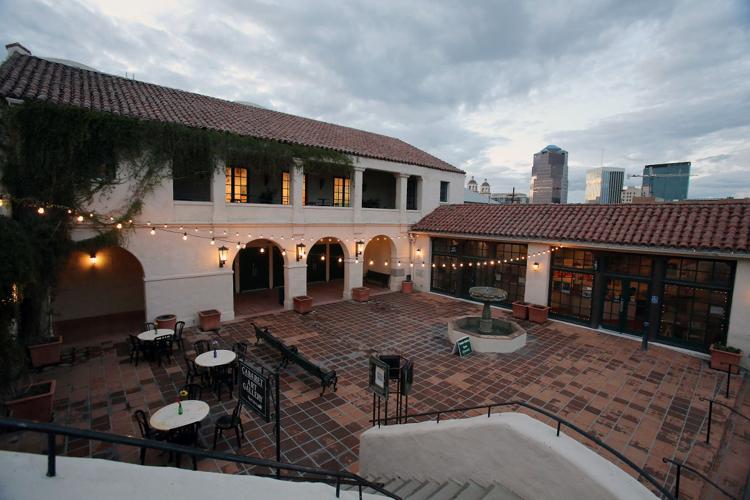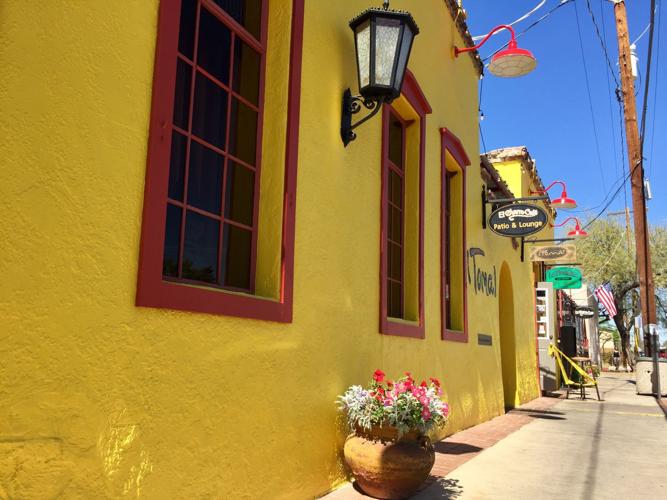To see how Tucson women have made history, just take a walk downtown.
We did.
In honor of Women's History Month, we decided to take advantage of the Tucson edition of the Arizona Women's Heritage Trail just steps outside of our office on Broadway.
Many, many steps. About 7,000.
The trail will take you from the heart of downtown into Barrio Viejo, down side streets and up into the funky old neighborhood surrounding the Tucson Museum of Art.
Wear comfy shoes and drink lots of water. Even 11 a.m. is hot hot hot. 😭 😭 😭
The whole tour took us about two hours. There are two versions: A shorter tour with eight stops on the south end of downtown, and a longer one that adds four stops north of Alameda Street. We went overachieved and went with the 12-stop tour.
The Arizona Women's Heritage Trail was officially launched in 2005 and initially funded by the Women's Foundation of Southern Arizona, according to the Star's archives.
To learn more information, visit womensheritagetrail.org. You can download a brochure with a map of the trail and descriptions of the significance of the 12-stops. It will also tell you how to get from site to site. Super helpful.
It's educational exercise — a double win.
1. Sosa-Carrillo-Frémont House, 151 S. Granada Ave.

The Sosa-Fremont-Carrillo house was spared from destruction as the city destroyed a number of historic buildings south of the downtown area as part of its march toward urban renewal. It is wedged between the Tucson Convention Center's music hall, left, and the meeting rooms. The photo was taken on Friday, October 16, 2015, in Tucson, Ariz. A.E. Araiza / Arizona Daily Star
The first stop on the tour is nestled within the Tucson Convention Center property, just south of the Music Hall.
We lucked out as someone with keys had just arrived to unlock the space when we got there. Inside, you'll find knickknacks and furniture that would have belonged to a territorial-era family. The Sosa-Carrillo-Frémont House is named for three families that lived there, and is the only house in what was once Barrio Libre to survive the construction of the TCC. It's on our tour because the house provides a glimpse into the lives of the women from the three families that lived here, including Elizabeth Frémont, the daughter of Arizona Territorial governor John Frémont.
2. El Tiradito, 420 S. Main Ave.

The El Tiradito shrine in Barrio Viejo on Main Ave. Friday, May 30, 2008.
For more than 120 years, people have come to this "wishing shrine" to light candles and pray. The story — maybe — of the shrine says it's the burial site of a murdered lover of a married woman. But no one is really sure. The shrine, with its blackened candlesticks and faded flowers, makes the list because of the care of Hispanic women who have long maintained the site, says the brochure.
3. Cushing Street Bar and Restaurant, 198 W. Cushing St.

Cushing Street Bar in 2008.
This is where Theresa Marx Ferrin used to live, aka the "Angel of Tucson." Ferrin lived in the building around the 1880s and 1890s and got her nickname because of her talent for whipping up natural and herbal cures. She helped patients on her own and also worked with Tucson's only doctor. Her fundraising efforts made possible the construction of Arizona's first Jewish synagogue at 564 S. Stone Ave. That congregation grew into Temple Emanu-El, which still meets at 225 N. Country Club Road.
4. El Teatro Carmen, 380 S. Meyer Ave.

From around 1914 to 1922 Teatro Carmen was an elegant theater in Barrio Viejo. In its day it was a venue for Spanish language productions that included operas, musicals and melodramas.
From 1914 to 1922, El Teatro Carmen, opened by Carmen Soto de Vasquez, brought the finest Spanish performances to Tucson. This was the good life for Hispanic culture in Tucson. But by the 1920s, movies and boxing became more popular than theater, and the El Teatro Carmen eventually closed.
5. Four Corners Chinese Markets, Convent Avenue and Simpson Street.

The corner of Simpson and Convent streets had four Chinese markets. Fok Yut Ngan, a woman who immigrated to the U.S. as a young bride, worked in her family's store on this corner.
This is the point in our journey where, if you saw our Instagram story, we became obsessed with doors — beautiful wooden things with ornate knockers and bright colors. You can't blame us.
The corner of Convent Avenue and Simpson Street is worth stopping at because, one, the doors. And two, the intersection once hosted four Chinese markets. A store and bakery there belonged to Fok Yut Ngan and her family. A young bride when she immigrated from China, she eventually learned English and Spanish working the family business. She also raised 10 kids. NBD.
6. Immaculate Heart School and Convent, 460 S. Sixth Ave.

The Academy Lofts in the southern section of downtown, at 35 E 15th St., on Oct 17, 2016, replaced the Immaculate Heart Academy in Tucson. Even with its distinctive look the facility offers modern conveniences and amenities.
This is the point in the tour when we started to fade. Shade became a hot — er, cool — commodity. Also, we made the mistake of not bringing water. (Lucky the office was close. Pro tips: Bring water and eat a solid meal before you come. Experience tells us Lucky Charms do not count.
This stately building is now apartments, Academy Lofts, in fact. That blew our minds. Imagine living somewhere like that.
We get to ogle Immaculate Heart School and Convent on this tour because of nuns from two different Catholic orders that taught here for more than 100 years. The Sisters of Saint Joseph used the place from 1885 to 1931 and then the Sisters of the Immaculate Heart taught until 1986, living in a convent out back.
7. Temple of Music and Art, 330 S. Scott Ave.

The courtyard of the Temple Of Music and Art is nearly identical to how it looked when first constructed. It will be the lounge area from the upcoming Tucson Festival of Films.
This dazzling white building wasn't always home to the Arizona Theatre Company. It was actually home to Madeline Heineman Berger's Saturday Morning Musical Club in the late 1920s.
This club of amateur performers and arts enthusiasts put on their own productions and spectacular shows.
Now, ATC puts on their own productions and spectacular shows. You can also eat mediterranean food from Simplicit.
At this point, we're tired and dehydrated. It was time to take a break.
8. Plaza de la Mesilla at La Placita, 100 S. Church Ave.

The downtown gazebo and small park remained after urban renewal razed or drastically modified the surrounding structures and businesses. The photo was taken on Sunday, October 11, 2015, in Tucson, Ariz. A.E. Araiza/ Arizona Daily Star
This colorful landmark used to house offices and retail shops, but soon it will be demolished to build more downtown housing.
Actually, this is about the park next to La Placita. The one with the gazebo. The La Placita committee, made up mostly by women, preserved this area and saved it from urban renewal. Irony.
This is the end of the short tour. Do you have what it takes to keep going?
We didn't but we did it anyway.
9. Former home of Sam and Atanacia Santa Cruz Hughes, 223 N. Main Ave.

Atanacia Santa Cruz Hughes lived here at 223 N. Main Ave. with her husband Sam Hughes. Born in 1850, she helped with the development of Tucson first when it was part of Mexico and then when it became part of the United States.
Besides having the prettiest name, Atanacia helped build Tucson when it was part of Mexico and then the U.S. This home housed her large family and every person of prominence.
10. El Presidio, 196 N. Court Ave.

El Presidio de San Agustín, foreground, in downtown Tucson dates back to 1776. By 1783, the city was a walled compound.
Tucson's oldest historical site is on this tour because women stayed there. That's it.
11. Stork's Nest, 221 N. Court Ave.

From the 1920s through the 1940s, Tucson women found refuge at the Stork's Nest, a maternity home at 221 N. Court Ave. that provided a safe option for labor and delivery in a town that only had one hospital. Today it houses Clean Creek Associates, a groundwater science consultant.
This was Tucson's first maternity ward between the 1920s and the 1940s.
12. El Charro, 311 N. Court Ave.

El Charro Café was opened by Monica Flin in 1922. The restaurant has operated here at 311 N. Court Ave. since 1968.
Monica Flin, being the badass that she is, opened El Charro by herself during a time when women didn't own their own businesses. That time was 1922 after two failed marriages.
This wasn't the original original location. She moved a couple times before settling here, but this has been the location since 1968.
El Charro is still thriving, 95 years later. And the chimichangas are still good.
Phew! We made it. That's the end of the tour.


